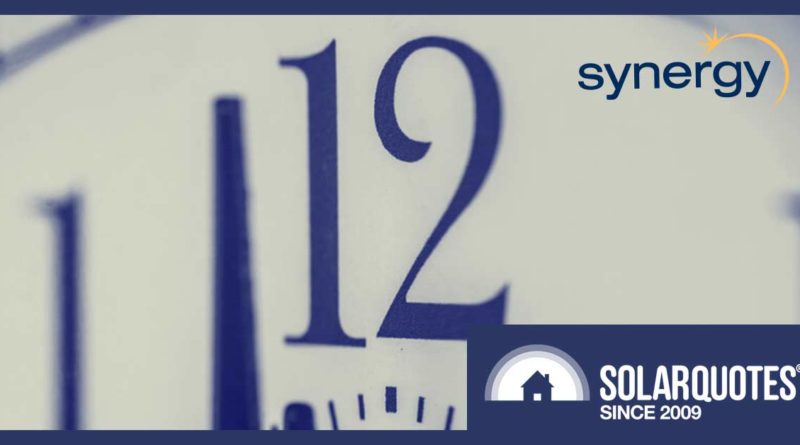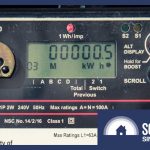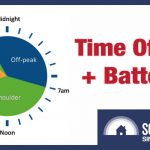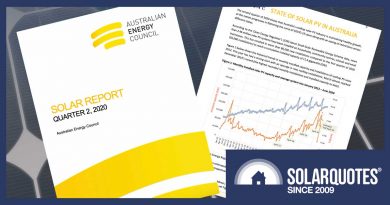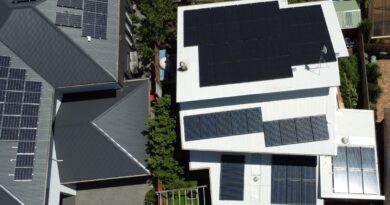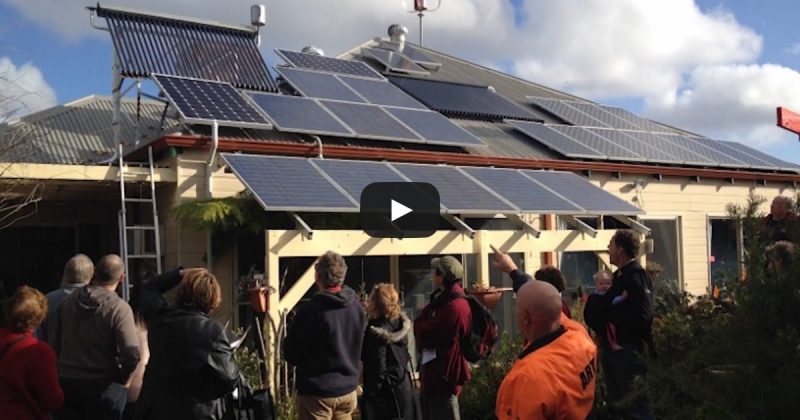Synergy’s Midday Saver Tariff: Home Batteries Can Pay in WA
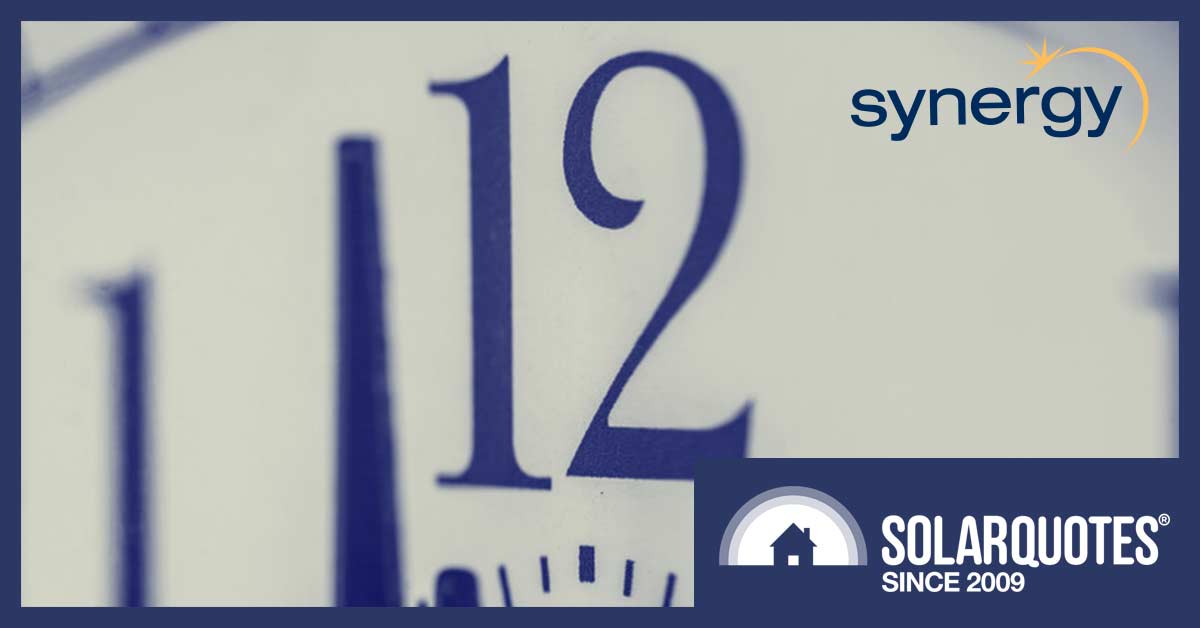
If you live in Perth, or within a four-hour drive, I have some good news. Synergy has changed its residential time-of-use tariff to 8 cents per kilowatt-hour for grid electricity from 9am to 3pm. They’ve also changed its name to “Midday Saver”.
Personally, I’m just glad they went for a name that’s apt, rather than calling it Persephone or something.
Whether Synergy’s Midday Saver will live up to its name and save money depends on what category you’re in:
- No Solar: Likely to save money, particularly if people are home during the day.
- Solar: Not likely to save money for most.
- Solar and Battery: Very worthwhile, unless the home uses very little grid electricity.
- Battery and No Solar: The Midday Saver tariff can allow a battery without solar to pay for itself. But this only makes sense for those who can’t install solar panels.
- Pool: If you own a pool, running its pump during the day can make the Midday Saver tariff pay.
- Electric Car: If you drive an EV and can charge it during the day — even only on the weekend — it can make Midday Saver worthwhile.
- Thrifty: Anyone willing to make the effort to shift their electricity consumption to the day — whether they have solar panels or not — may find it can save them money.
I’ve estimated the average cost of grid electricity for a typical WA home if they are on Midday Saver:
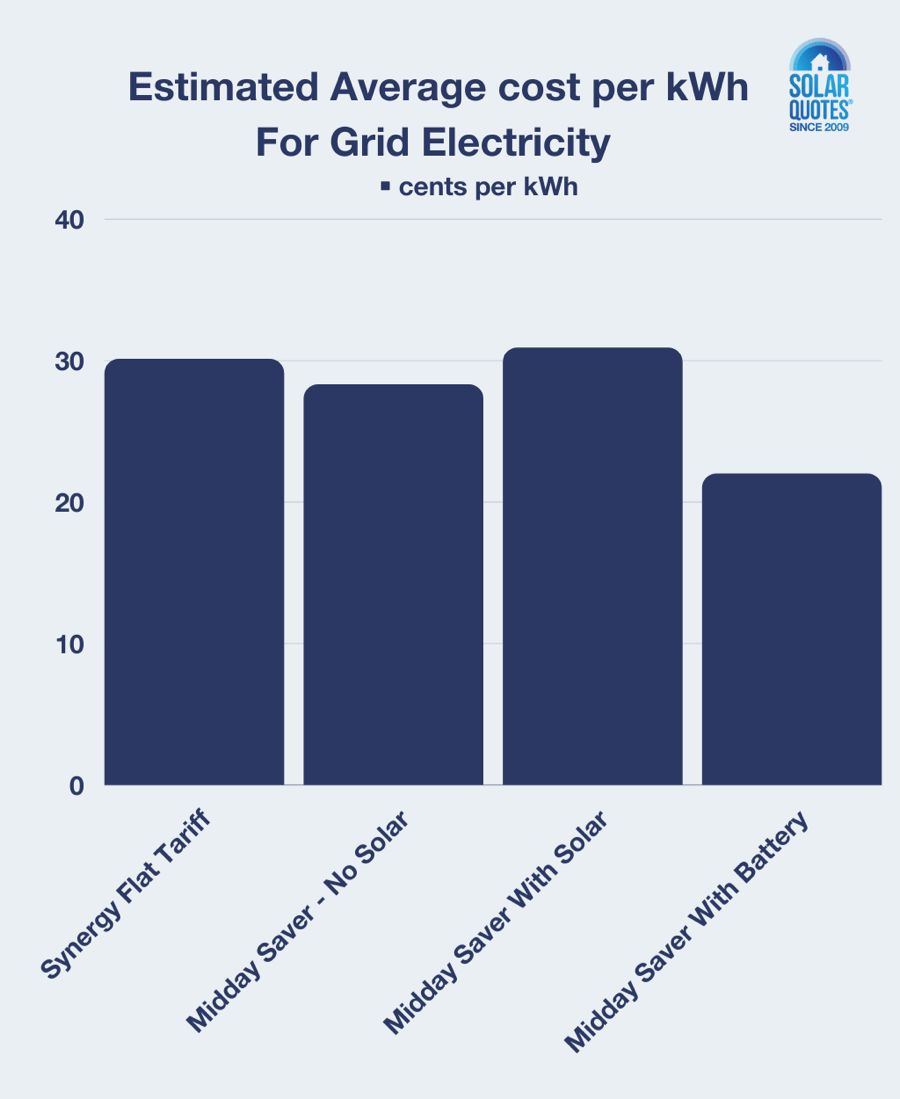
As you can see the best-suited homes for this tariff are battery powered.
- If you have a battery and solar on Midday Saver, you can save up to $860 compared to a typical home without a battery on the same tariff.
- If you have a battery and no solar on Midday Saver, you can save up to $746 compared to a typical home without a battery on the same tariff.
I’ll give more details below and show my workings so you can decide if it’s good news for you. Like my uncle always used to say, “Never lick a gift horse in the mouth”.

Persephone, Queen of the Underworld, approves of the Midday Saver tariff.
Good News For WA
Most won’t regard an improved time-of-use tariff as anything amazing, but I’m still glad I can offer this small bit of good news. This is because WA has it tough when it comes to grid electricity:
- Grid electricity prices are well above the national average.
- High daily supply charges place a hefty burden on low-income households while freeing up money for high-income earners to spend on hookers1 and cocaine2.
- Solar feed-in tariffs are the lowest and most restrictive in the country.
Before the recent run-up in wholesale electricity prices in the eastern states, whenever we felt sad about the state of the electricity sector here on the habitable side of the continent, we’d look at Western Australia to make us feel better. Now the eastern states are having a wholesale electricity crisis, it’s your turn to laugh at us. I recommend laughing it up big time because you’ve got a long way to go until we’re even.
The Synergy Area
Most Western Australians live in the Synergy area, which is around the size of Uganda. This map of proposed electric vehicle charging stations shows it in blue:
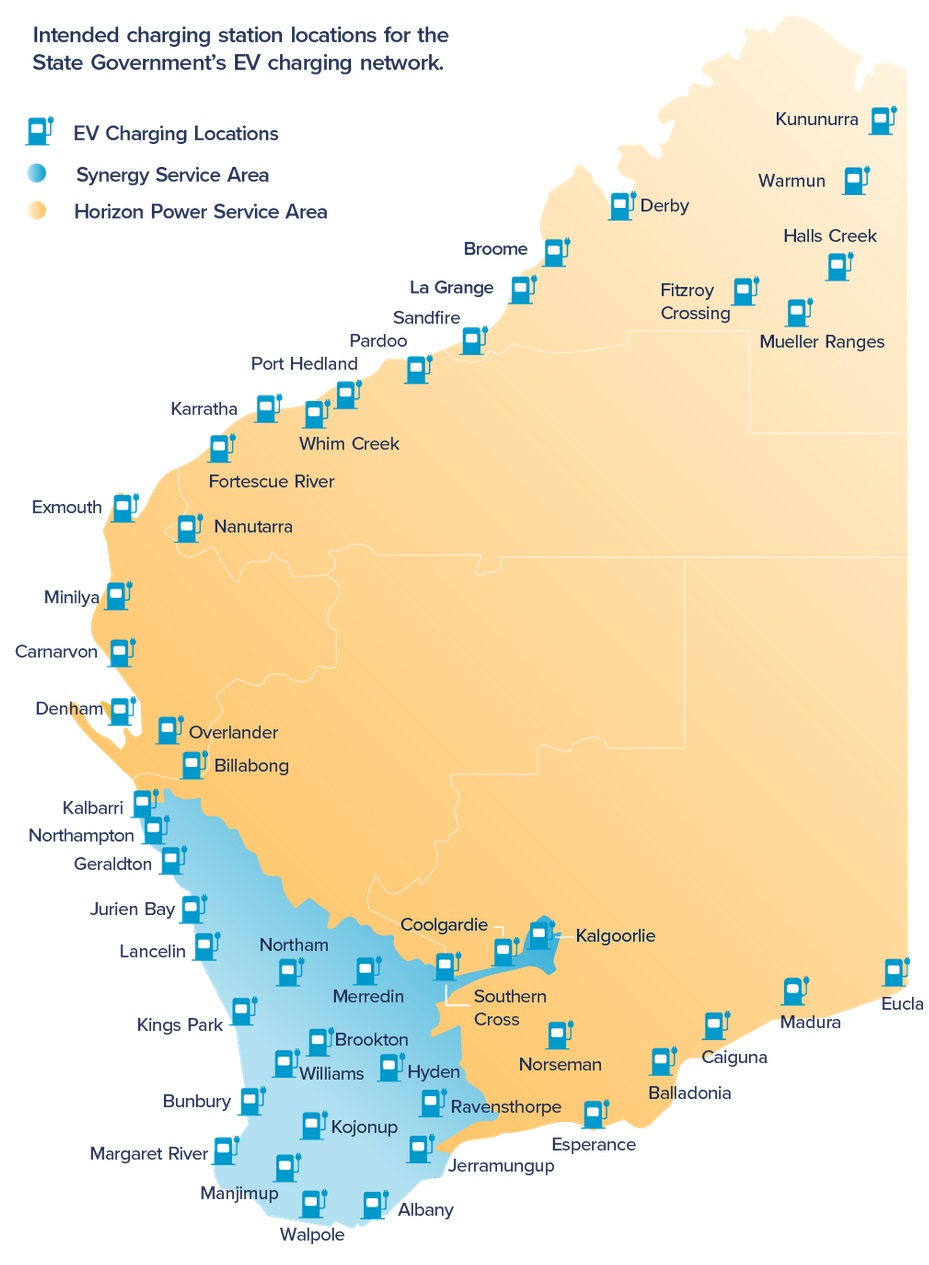
These EV chargers should all be installed by 2024, so feel free to drive on through electric avenue — kilowatts will take you further.
It’s not a small area. You can fit around three Tasmanias in the blue bit — if you don’t mind squishing them together to fill the gaps.
If you are on-grid but don’t live in the blue area, then Horizon is your network operator. They don’t currently have time-of-use tariffs, so Synergy Midday Saver is not an option.
Smart Meter Required
To use the Midday Saver time-of-use tariff, you need a smart meter. If you still have an old meter and get a solar power system installed, it will be replaced with a smart one.
Synergy Midday Saver Times & Charges
The Midday Saver tariff has three rates. The times and charges per kilowatt-hour, including GST, are:
- Super Off-Peak (9am to 3pm): 8 cents
- Off Peak (9pm to 9am): 22 cents
- Peak (3pm to 9pm): 50 cents
These periods occur every day of the week, including public holidays.
If you’d like that exact same information, but with coloured circles next to it, here’s the graphic Synergy uses with the prices tacked on in red:
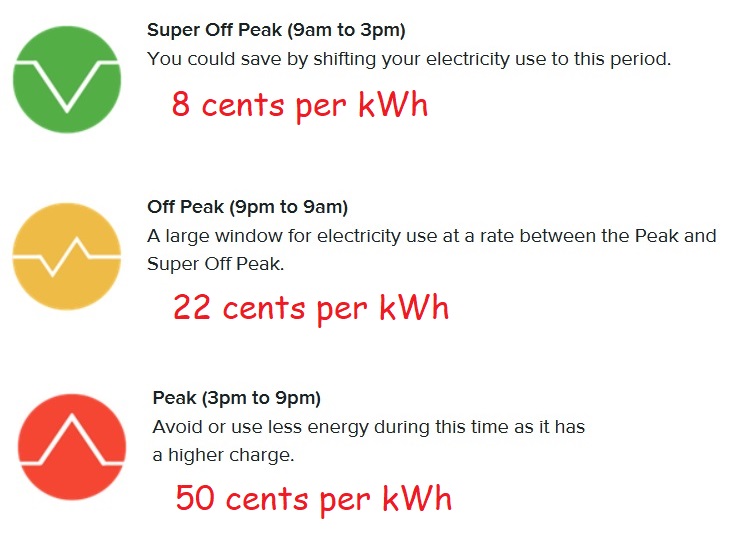
On top of these per kilowatt-hour charges, there’s also a hefty daily supply charge of $1.20.
The whole purpose of the Synergy Midday Saver tariff is to encourage people to shift electricity consumption from the late afternoon and evening to the middle of the day when solar energy makes it cheap and easy to supply.
Synergy Flat Tariff Rates
Unless you run a home business and qualify for their Home Business Plan, the only other choice available to households in the Synergy area is a flat tariff called the Synergy Home Plan (A1) tariff. This charges the same amount per kilowatt-hour of grid electricity, no matter when it’s consumed. Its charges, including GST, are:
- Per kilowatt-hour charge: 30.1 cents per kilowatt-hour
- Daily supply charge: $1.08 per day
Whether a home will be better off with the flat tariff or Midday Saver mainly depends on when they use their grid electricity.
A Stupid Comparison — Constant Electricity Consumption
I’ll begin the comparison between the flat and time-of-use tariffs by looking at which would be better for a home that consumes a constant quantity of grid electricity. This is a stupid comparison because it never happens in real life, but it is a starting point. If we only consider the per kilowatt-hour charges, then a home that always consumed grid electricity constantly would pay an average of…
- Flat tariff: 30.1 cents per kilowatt-hour
- Midday Saver time-of-use tariff: 25.5 cents
As you can see, the Midday Saver comes out ahead and is 15% cheaper. But this doesn’t take into account the higher daily supply charge for the Synergy Midday Saver tariff. For a home that consumes 5,000 kilowatt-hours of grid electricity per year, they would pay…
- Flat tariff: 38 cents per kilowatt-hour (Annual bill = $1,900)
- Midday Saver time-of-use tariff: 34.3 cents (Annual bill = $1,715)
Midday Saver is still cheaper, but now only by 10%.
If the home used less than 885 kilowatt-hours of grid electricity per year, then the flat tariff’s lower daily supply charge would make it the cheapest.
But these results don’t really matter, as no one has a home that consumes an unvarying quantity of grid electricity. But if they did, they should definitely call it “Constant Cottage”.
A Stupid Comparison — No Solar Household
Now I’ll consider a home with a more realistic electricity consumption pattern but without a solar power system. I’ll also call this a stupid comparison because not having solar panels in Perth is pretty dim. This may seem unfair, as there can be perfectly valid reasons for not installing solar, but don’t worry — the imaginary person living in this imaginary house is a complete idiot. He drives an imaginary Hummer and thinks imaginary Putin is a great guy. He’s so stupid he even admires imaginary Trump.
First, I’ll have to decide what this home’s average electricity consumption throughout the day is. This varies from household to household and depends on when people are home, if it has natural gas, a swimming pool, a swimming pool of liquid natural gas3, an EV, etc.
To make things worse, I don’t have good data for Perth electricity consumption patterns. But, for a typical, non-solar home — which, in Perth, has a gas connection — the average power draw through the day should look something like this:
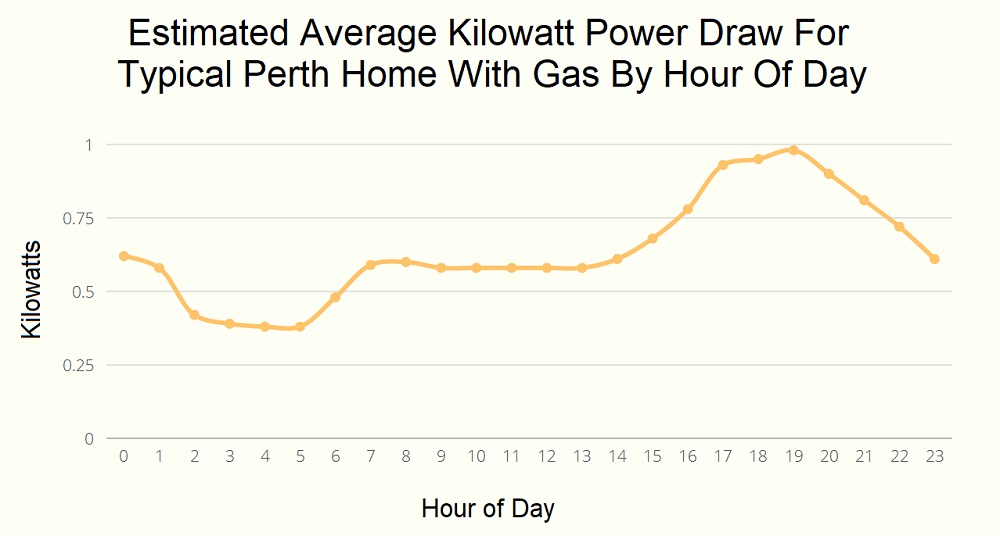
For a home with this electricity consumption pattern, the average per kilowatt-hour charge would be:
- Flat tariff: 30.1 cents per kilowatt-hour
- Midday Saver time-of-use tariff: 28.3 cents per kilowatt-hour
That’s not a bad result for the Midday Saver as it comes out 1.8 cents cheaper. But because of daily supply charges, it’s not as good as it looks. Once they’re included, for a home that consumes 5,500 kilowatt-hours of grid electricity annually, there is only a one cent difference per kilowatt-hour consumed:
- Flat tariff: 37.3 cents per kilowatt-hour (Annual bill = $2,050)
- Midday Saver time-of-use tariff: 36.3 cents (Annual bill = $1,995)
This makes the Midday Saver less than 3% cheaper than the flat tariff, but the $55 annual saving this gives is enough to make changing over worthwhile.
This result is for a typical home. There will still be plenty of households where people are usually out during the day. If they don’t have any electrical loads they can shift to the daytime super off-peak period — or couldn’t be arsed to make the effort — they will be better off with a flat tariff. Fortunately, it often doesn’t take much effort to shift enough consumption to the daytime to make it worthwhile.
Solar Household Comparison
Now I’ll compare Synergy flat and Midday Saver tariffs for a home with a solar system. I’ll tell you now, for the typical solar home, Midday Saver doesn’t come out ahead. This is because Perth is a great location for solar power. It’s the sunniest capital with an annual average of 3,212 hours of bright sunshine per year. That’s an average of 8.8 hours a day or 73% of the time the sun’s above the horizon. Over a year, Perth averages…
- Sunny days (~25% or less cloud cover): 149
- Partially sunny (~25% to ~75% cloud cover): 121
- Cloudy (~75% or more cloud cover): 95
Thanks to this, Perth is one of the best cities in the world for solar energy generation. It’s on par with Los Angeles, which also has millions of people hanging out next to a desert, except the beer isn’t as good and the coffee is far worse.
If a typical Perth home that consumes around 5,500 kilowatt-hours a year installed a 6.6 kilowatt solar system — and made no change to their electricity consumption patterns — their average grid power draw through the day would look something like this:
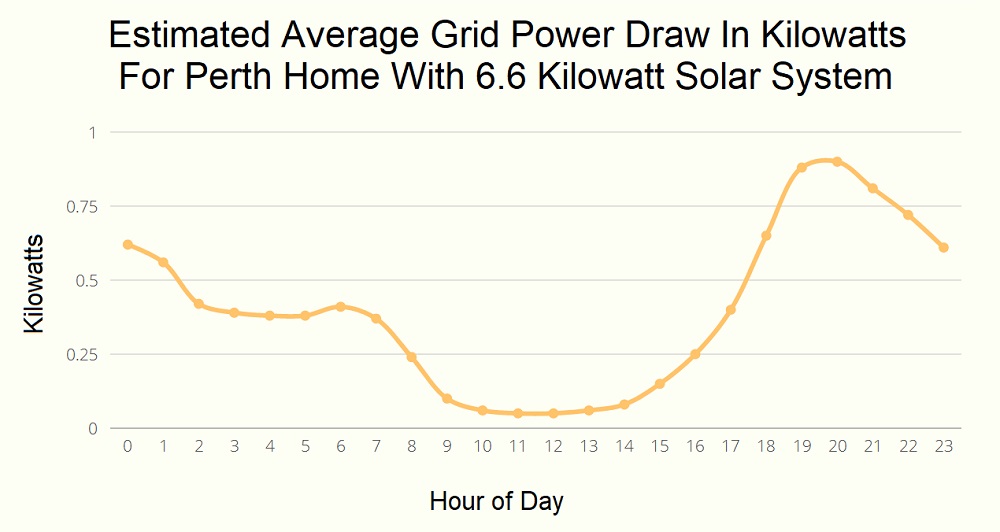
Thanks to excellent solar energy output, the home normally consumes no grid electricity around the middle of the day when the sky is clear. But some grid consumption will occur on cloudy days or during brief periods when household power draw is high.
Thanks to solar power, instead of consuming around 5,500 kilowatt-hours of grid electricity per year, the home instead consumes around 3,500. That’s an average of 9.5 kilowatt-hours per day instead of 15. Electricity consumption during the Midday Saver peak period from 3 pm to 9 pm is one-third of their total grid electricity consumption.
If we only consider the average per kilowatt-hour charges, then this example home will pay…
- Flat tariff: 30.1 cents per kilowatt-hour
- Midday Saver time-of-use tariff: 30.9 cents per kilowatt-hour
The Midday saver averages out at 0.8 cents more. But it gets worse when daily supply charges are considered:
- Flat tariff: 41.1 cents per kilowatt-hour (Annual bill = $1,475)
- Midday Saver time-of-use tariff: 43.5 cents per kilowatt-hour (Annual bill = $1,514)
This example home would be around $40 a year worse off on the Synergy Midday Saver tariff. In most cases, solar households will be better off on the flat tariff. But if their peak period grid electricity consumption is under 28% of their total grid consumption, then Midday Saver can be cheaper.
Because many solar homes have already made an effort to shift electricity consumption to the daytime when it’s effectively far cheaper for them, there will be many that can save money by switching to the Midday Saver tariff. But to avoid disappointment, I do recommend checking that peak period grid consumption will only be a modest portion of total grid consumption before changing.
Battery Homes
Most — but not all — homes with batteries should use Synergy’s Midday Saver, as it will be true to its name and save money. Provided the battery works and can meet a significant portion of evening demand, it’s likely to be worthwhile. If the battery, along with solar panels, supplies almost all household consumption from 3pm to 9pm, then the average per kilowatt-hour charge will be around the off-peak rate of 22 cents.
The exception is if the household consumes very little grid electricity. This is not difficult to achieve with the right solar and battery setup, but it can also be done by having a very energy-efficient home or simply being extremely frugal. If you have a battery and consume an average of under 3.7 kilowatt-hours of grid electricity a day — around 1,300 kilowatt-hours per year — you’re likely to be better off on the flat tariff thanks to its lower daily supply charge.
If you don’t have a battery and simply use very little grid electricity, you’ll probably have to consume an average of under 1 kilowatt-hour of peak electricity per day to be better off with the flat tariff.
Battery Limitations
Many assume a home battery will allow peak charges to be avoided entirely, provided they don’t consume more energy than the battery stores or draw more power than it can supply. But, in practice, home battery systems normally only discharge energy if the home is already drawing a minimum amount of grid power. This varies but can be around 100 watts.
It can cause a home with plenty of stored energy in its battery to use 0.6 kilowatt-hours of grid electricity over the six hour peak period. In most cases it would be less than this, thanks to solar providing some power early in the peak period and household consumption sometimes being below 100 watts, but this minimum grid draw before the battery discharges could potentially result in around $100 of peak period electricity consumption per year.
Midday Saver Improves Battery Economics
The Synergy Midday Saver tariff can significantly improve the financial return from batteries. If one is charged with electricity that otherwise would have received a 2.5 cent DEBS solar feed-in tariff, then every kilowatt-hour of peak electricity consumption displaced by battery energy will save the household around 47.1 cents after accounting for typical battery losses.
Avoiding an average of 5 kilowatt-hours of peak consumption per evening would save a battery household $860 a year. But don’t get too carried away by this calculation. If a home would be better off on a flat tariff before it gets a battery, then the amount it would pay on that tariff should be the starting point for determining savings.
The actual return from using the Midday Saver tariff with a battery will depend on the battery characteristics and household electricity consumption patterns, but there will now be a considerable number of households in and around Perth where batteries will pay for themselves.
There will also be a large number of households where batteries don’t yet make financial sense, so don’t rush into it until you’re confident you’re likely to be happy with the results. My two main recommendations for tipping the odds of battery bliss in your favour are:
- Use a battery from a manufacturer with a record of reliability and good warranty support.
- Most important of all — use an installer who does high-quality work and is happy to return as often as required to fix any problems that crop up.
Neither of these points is likely to apply if you buy the cheapest battery available.
A Battery Without Solar Panels
The Midday Saver tariff also makes it possible for batteries to pay for themselves in homes without solar. The return isn’t as good, but is still high enough for it to potentially pay for itself. Charging a battery at the 8 cent super off-peak rate and discharging it during the peak period would save a household around 40.9 cents per kilowatt-hour. If it displaced an average of 5 kilowatt-hours of peak electricity use per day, it could save around $746 a year.
While this is $114 less than if the battery was charged with solar energy that otherwise would have received a DEBS feed-in tariff, there will still be plenty who’ll consider that return worthwhile.
Once again, if the home would be paying less with a flat tariff before getting a battery, this should be used as the starting point for calculating savings. But homes without solar power are less likely to be better off on a flat tariff.
It only makes sense to get a battery without solar if solar panels can’t be installed. This is because the return from solar power is far better. But there are plenty of people who own a home but don’t own a roof, so it can definitely make sense.
EVs & Midday Saver
If you have an EV and can charge it during the day — even only on weekends — it’s very likely to make Synergy’s Midday Saver worthwhile. While it’s cheaper to charge off solar, on cloudy days you can be confident none of the electricity used to charge your vehicle’s battery pack from 9am to 3pm will cost you more than 8 cents per kilowatt-hour.
On average, passenger cars in WA are driven under 250km a week. As nearly every new EV these days has greater range, it means most owners will be able to get by with only charging on weekends if required. A single-phase home EV charger can provide a Tesla Model 3 with over 250km of range in one 6 hour super off-peak period. Less energy efficient EVs may only gain around 210km range in that time and so may require more than one charging period per week.
Load Shifting Can Make Midday Saver Pay
Whether a home has solar panels or not, shifting electricity consumption to the middle of the day can make the Synergy Midday Saver tariff worthwhile. This can be as simple as turning the dishwasher on in the morning after 9pm or putting the pool pump on a timer. More involved steps can include:
- Replacing a gas hot water system with an electric one that switches on during the day.
- Insulating the home so it can be warmed or cooled during the super off-peak period and remain comfortable through the evening.
- Working at home at least some of the time to take advantage of cheap daytime electricity.
A Good Reason To Get Off Gas
WA has the least expensive domestic gas in the country, but that doesn’t mean it’s cheap. Going on the Midday Saver tariff is a great opportunity to get off gas, even if a home doesn’t have solar, because…
- Homes can be heated during the Super Off-Peak period with electrical resistance heating for under half the cost of natural gas or a small fraction of its cost if a reverse cycle air conditioner is used.
- An electric hot water system set to switch on during the day will operate at half the cost of gas or far less if an energy-efficient heat pump hot water system is installed.
- An induction stove is safer than gas and can heat food faster.
- If you go off gas altogether, you’ll no longer have to pay a supply charge of at least 21 cents per day. This will save at least $77 a year.
- You won’t need to pay to have gas appliances regularly serviced, as the WA Department of Commerce recommends.

These natural gas burners on the SpaceX Starship can cook your food faster than an induction stove — but I don’t recommend installing them in your kitchen. (Image: Jack Beyer’s twitter.)
Synergy Needs To Improve The Midday Saver Tariff
Both the flat tariff and the Midday Saver have high daily supply charges of over $1. High supply charges aren’t good, but what is really stupid is the Synergy Midday Saver has one higher than the flat tariff.
This means people who have batteries and low grid electricity consumption are incentivised to use the flat tariff and then have no incentive to make sure they use their stored battery energy during the peak period. This is so stupid it’s causing my vocabulary, which is normally replete with adjectives, to seize up and fail. It’s just stupid, stupid, stupid, stupid, stupid.
Different daily supply charges also make it hard for people to decide if they’d be better off on the Midday Saver. This is also extremely stupid, as Synergy exists to serve the people of Western Australia. It’s not there to confuse them. Synergy doesn’t benefit from making it hard for people to decide if they would be better off changing to a different retailer, as they are the only game in town — plus an additional area the size of Uganda.
It’s good that Synergy offers households a choice between a flat tariff and the time-of-use Midday Saver, but the daily supply charges should be equal or — even better — completely eliminated.
A Better Future
Western Australia has plenty of potential to lead the world in home batteries and rooftop solar power. Unfortunately, they keep futzing up and letting weird places like South Australia take the lead. But it’s not too late for WA to pull ahead.
Conditions are practically perfect for a distributed energy future. The improved Synergy Midday Saver time-of-use tariff helps, but just a few more simple changes would allow solar and battery uptake to go gangbusters and solve — most — of their electricity sector woes. But because Western Australia’s leadership rarely sees what’s right under its nose, I’ll have to spell this out in a future article.
Footnotes
- A type of football player. ↩
- A type of illegal drug. In Adelaide it’s called “wealthy meth”. ↩
- The refrigeration cost for one of them is immense. ↩
Original Source: https://www.solarquotes.com.au/blog/synergy-midday-saver-review/

